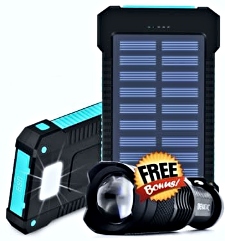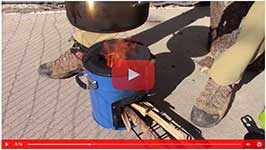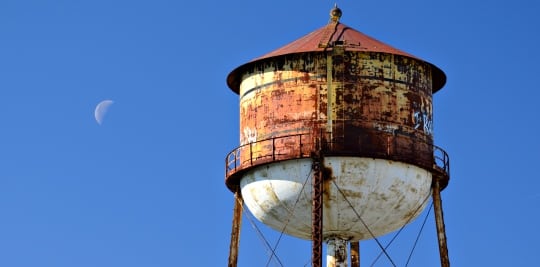
A Complete Guide To Purifying Water In An Emergency
Water purification ensures was is drinkable.
It removes (or kills) undesirable chemicals, biological contaminants, suspended solids, and gasses.
Why is THIS so important?
Because all living organisms need clean water to survive.
Humans are no different, and it’s been true throughout human history…
So today, I’m going to dive into the following water purification topics:
TOPICS IN THIS GUIDE… ↓(click to jump)
- The Importance Of Water
- Water Purification Concerns
- Types of Water Contaminants
- 4 Water Purification Methods
- My Personal Recommendation

Want a free last resort water checklist?
Click here to instantly download this Complete Checklist. No purchase necessary.The Importance Of Water
In fact, if you look for locations where human societies have grown, developed, and prospered, you’ll notice they all have one thing in common:
An abundant source of clean water.
The search for abundant, clean, reliable drinking water is THE driving need for society.
↓ How do cities get enough fresh water?
And once such a water source is found, tribes, towns, and cities spring up.
A large group of people living in a single location is impossible without a large body of water nearby.
- Phoenix, Arizona, is built on the Salt River.
- Denver, Colorado, is built in the shadow of the Rocky Mountains snow melts.
- Las Vegas was only possible thanks to the damming of the Colorado River to create Lake Mead.
- Egypt’s history is inextricably linked to the Nile; its annual cycle of flooding was used to irrigate crops and provide clean drinking water for its large population.
- Every long-lasting city or town must procure and deliver clean water to its citizens. If the water is not abundant or it’s contaminated, people will leave.
However, when many people live in the same space, they create an overwhelming clean water challenge:
Sanitation.
- Humans are dirty.
- We create lots of gross waste.
- Waste can easily contaminate the very water we drink.
And drinking polluted water is hazardous to your health.
Even in ancient times, people understood the difference between good and bad water.
Dirty water tasted bad; clean water tasted good.
It was also common knowledge that dirty water was somehow related to illness.
And this was way before the microscope.
People require clean water, always. And always will.
But it wasn’t until the middle 19th century that the spread of diseases, cholera specifically, was scientifically linked to contaminated public water sources.
The man who linked cholera to a public water source in London was named John Snow.
↓ The Pandemic the World Has Forgotten
Ok, I’ve made my point; drinking contaminated water is bad for humans.
So for our purposes, I’m going to jump to the present.
Present Day Water Purification Concerns
With technology, we now take tap water for granted.
When we turn on the tap, clean water will flow.
This convenience is everywhere in our lives.
We use tap water for cooking, cleaning, washing, drinking, and flushing in our homes.
“The average American family of four uses 400 gallons of water per day. On average, approximately 70 percent of that water is used indoors, with the bathroom being the largest consumer.”
Also interesting but hardly surprising, the EPA also estimates that 90 percent of the world’s water is contaminated.
↓ How “forever chemicals” polluted Americas water
If The Grid Goes Down…
If the power grid goes down for an extended period (due to a winter storm, an emp attack, etc.), the water pumps won’t run long.
Water won’t just magically keep flowing out of your taps.
Taps need pressure to operate.
Water pressure is the force that shoves water through the pipes and out your taps.
But water pressure rarely occurs naturally.
In most cities, water pressure comes from a mechanical process.
Pumps push the water into a large storage container located at an elevation higher than the homes it services.
This large water storage container is often called a water tower.
↓ How Water Towers Work
Once water is at this higher elevation, gravity (potential energy) can do its job to create the necessary water pressure in our homes.
The bottom line is this:
It requires water pumps to make this magic happen.
- No electricity = no water pumps (unless it’s a solar water pump).
- Zero water pumps = zero water pressure.
- No water pressure, no water coming out of your water taps.
So if disaster strikes your hometown, the fragile masses will thirst.
They will be forced to mass evacuate and venture to the nearest abundant water source. That’s an entirely different challenge.
So let’s assume you have a stockpile of water to draw from.
Are you confident this water source won’t make you severely sick?
The answer is, you’re not certain; you need to invest in some water purification methods.

Want a free 78 item prepper checklist?
Click here to instantly download this Complete Checklist PDF. No purchase necessary.Types of Water Contaminations
Before going into the water purification methods, let’s review some unhealthy water types.
There is biological contamination, which means microorganisms, Giardia, for example.
This common little bug will cause intestinal disorders.
Another type of polluted water is called toxic, which means chemical contamination.
Toxic water can result from leaky gas or fuel tanks seeping into waterways or entering the water table.
Corroded lead water pipes can also cause it (think Flint, Michigan).
4 Water Purification Methods
There are numerous water purification systems available.
I will list the most popular below and address some of the pros and cons of each.
From the water pitcher, which you fill with tap water, and then let the water gravity flow through a replaceable filter cartridge…
To the portable water filter, which can be carried in a bug-out bag or backpack, and uses a syringe mechanism to force water through an integral filter.
Both are useful in many situations.
Depending on your circumstances, you’ll get to choose which is best for you and your family.
However, at the bare minimum, the water purification system you select must be able to stop pathogenic organisms.
Common bugs that are waiting to infect you in untreated water include (but are not limited to):
- E.coli
- Cholera
- Hepatitis
- Giardia
- Polio
- Plus all kinds of exotic protozoans and metazoans, which can infect your blood, brain, and internal organs
You don’t need to become obsessed with microbiology; you need to understand unfiltered water is dangerous.
Below is a list of the major filtration and water purification systems and chemicals you can use to make your water safe to drink.
1. Boiling: Kill With Heat
Boiling water kills a lot of different bugs, but not all.
The World Health Organization (WHO) recommends bringing water to a rolling boil, then letting it cool down naturally before consuming it.
This will kill the most common disease-causing pathogens, viruses, and bacteria.
↓ Boil Water Notifications – How to Properly Boil Water
However, a pressure cooker can only kill some pathogens by superheating water.
But regular boiling will kill the majority of harmful “bugs.”
The biggest downside of relying on boiling for water purification is how time-consuming it is.
First, you need a heat source.
And in an emergency, forget about using a stovetop.
So you have to build a fire.
Then you have to put water into a fire-safe pot and wait for it to reach a full rolling boil.
Next, you have to let it cool before drinking it.
So while boiling is effective, it’s inefficient for purifying lots of water.
Boiling water also will not remove particulates (such as toxic metals); to remove those, your best bet is filtration.
Here’s a short video on how to boil water in the wilderness with hot rocks.
↓ How to Purify Water for Rock Boiling
2. Filter Out The Impurities
There are many water filtration options, and most use a ceramic filter.
Many are designed with hand pumps, easy to use, and small enough to carry with you wherever you’re headed.
Or wherever you happen to be.
Most of these filters trap microscopic particulates down to a size of 0.2- 0.3 micrometers.
But they don’t trap tiny viruses, so chemical treatment is necessary if you want to be really safe!
Activated charcoal absorbs many toxins and improves the taste of water, so it’s frequently used with hand-held pump-type filters.
Combination ceramic/carbon core filters are the best all-around filter type.
The biggest downside of using a water pitcher for filtration is the expense of buying and maintaining them.
You must purchase the pitcher and replace the filter periodically, which is an ongoing expense.
Plus, if you’re preparing for a widespread emergency, you must stock up on replacement filters beforehand.
And the largest downside to portable filters in the past was their limited life.
Similar to the replacement issue with the water pitchers, most of these personal filters don’t have replacement filters and you throw away the device once it’s used up.
↓ How to purify and filter water, making it safe to drink
Update: Introducing The Sawyer Mini
I highly recommend you get a couple sawyer mini water filters.
Wait? Mini? A mini water filter? Yes, it’s mini in size but not in volume.
It can filter 100,000 gallons of water!

Perfect for your water storage plan.
What makes the Sawyer Mini so powerful is its inline design capabilities.
You can use a simple rubber hose to add a Sawyer Mini between your water storage containers and create a large, completely passive gravity filter with a single Sawyer Mini.
Saving you hundreds of dollars vs. traditional gravity water filters!
Here’s my review video of the Sawyer Mini.
↓ Sawyer Mini Water Filter Review – Can This Filter 100,000
3. Kill With Chemicals
Halogens, mainly chlorine and iodine, are used to disinfect water chemically.
Chlorine bleach is available almost everywhere and, when used with iodine, will kill the most common pathogens in natural water.
↓ How to PURIFY WATER with BLEACH and make it SAFE!!!
Water purifying tablets use chemicals to kill biological contaminants in water, rendering them safe for drinking.
They are usually effervescent and dissolve rapidly in water.
They kill microorganisms by using different chemicals based on the tablet’s manufacturer.
Some tablets use iodine or forms of chlorine, such as NaDCC (Sodium Dichloroisocyanurate, which is sometimes called Triclosan Sodium), to kill organisms that may be present in the water.
Water purification tablets are ideal for adding to a pack or carrying in a bug-out bag.
↓ Aquatabs are the BEST Water Treatment Tablet
Ultimately you get to decide which chemical water purification method to use, but it’s hard to go wrong with good old Clorox.
One concern with using chemicals to treat your water is messing up the ratios.
Consuming overly treated water can be a health hazard, especially for kids and the elderly.
Also, chemical treatments can’t protect water from hazardous particulates like lead.
Lead is a metal, and chemical treatment won’t remove it; filtration is your best bet for removing harmful particulates.
4. Kill With UV Light
UV light purifies water by inducing the formation of covalent linkages in DNA.
This prevents microbes from reproducing.
Well, actually, it doesn’t kill microbes; it “turns off” their ability to reproduce.
The UV-treated water must either be consumed immediately or stored in light-resistant containers because normal exposure to light can re-activate the microbes.
Steri Pen is the leading portable UV Light manufacturer.
Again, this method will prevent you from getting sick from biological viruses but not particulates or chemicals; you’ll need filtration for that.
Here’s a video of how a portable UV pen works:
↓ Steripen UltraLight Water Purifier
My Personal Recommendation
You need multiple ways to purify your water for an emergency.
And if you stock up a heat source with firewood (and you should), then you can always boil it in a pinch.
You should also stockpile chemical treatments.
You can either buy lots of water purification tablets online or buy bleach in bulk.
I also really like the UV option to stash in my survival pack, bug out bag, and get home bag.
Here’s the UV Steri Pen I pack in my bug out bag.

I recommend you check out the Anytime Charge Power Bank Solar Charger.
This solar charger is ideal for clipping onto a pack and collecting the sun’s rays for energy.
The Anytime Charge Power Bank is an excellent piece of survival gear that you can use in everyday life as well.
With each of these water purification methods, you cannot “kill” particulate contaminations; you must filter those out.
So in conjunction with boiling, chemical treatment, and UV light, you also need a water filtration plan.
Having each of these options will help provide redundancy to most biological hazards and remove harmful particulates.
Other Water Purification Things to Consider
Besides filtering water, you should consider storing water and identifying clean water sources in rural areas.
If you’re in an urban area, you’ll depend on the local municipal water supply. That makes storing water a major priority.
Another opportunity is to install a rainwater collection system – if your local authorities allow it, it’s a smart setup to put in place.
If things get out of control in society, the supply of abundant clean water could evaporate, and that, in turn, could lead to all sorts of chaos.
You don’t want to gamble by consuming filthy water.
Here’s your simple action plan
- Practice Boiling Water Over Fire
- Purchase A Good Water Pitcher and Stock Up On Filters
- Buy Several Portable Water Filters
- Purchase A Good UV Light Pen (and figure out a way to recharge your batteries without grid power)
- Stock Up On Some Bulk Chlorine Bleach or Purification Tablets
Do these 5 action steps, and you’ll have all your water purification bases covered for today, tomorrow, and the future.
Why Trust Skilled Survival...
Go here now to review a full breakdown of:
- Who We Are
- Our Credentials
- Our Mission
- & Product Recommendations...
Here are a few highlights of our teams credentials & certifications:
- Certified Member of a Mountain Search & Rescue Organization
- Plant Emergency & Safety Leader for a Major Food Manufacturer
- Member of the 10TH Mountain Division Hut Association
- Certifications: Avalanche 1, WFR, CPR
- Official Gear Tester for Numerous Outdoor Gear Companies
- Countless Multiday Backpacking trips into Remote Wilderness
- Bachelor's Degree In Mechanical Engineering
- Bachelor's Degree In Civil Engineering
- Bachelor's Degree In Biomedical Engineering
"It takes 20 years to build a reputation and five minutes to ruin it." - Warren Buffett
We're fully aware that trust is NOT something you GET but is EARNED.
And we'll continue to earn YOUR trust through our forthright and honest approach with each new Blog Post, Guide & Product we create...
Prepare, Adapt & Overcome,



Recommended Reading
Survival Pack: How To Build One NOW (before SHTF)
Survival pack list From Scratch. Packs That Will Make You A Hero To Your Family. Plus, Some Of Th Best Packs You Can Buy
Best Survival Packing List To Plan For An Evacuation
Everyone needs a survival packing list to organize their escape. That way you won't regret leaving something critical behind.
13 Best Wild Edibles ANYONE Can Find Nearly Everywhere…
Discover the best wild edible plants you can find and eat nearly anywere. Knowing and identifying these wild edibles could save your life.
How To Make Catfish Bait: My Grandpa’s Ultimate Recipe
I want to share with you what I consider the best catfish bait recipe. Here's how to make stink bait that will get the catfish to bite.
Paracord Projects: 17 Survival Devices You Can Make
I share the best paracord projects that are both fun and useful. By doing these crafts you'll always have lifesaving cordage on hand.
Best Survival Skills Every Adventurer Should Learn
The best survival skills will keep you alive even in extreme conditions. 1. Water 2. Shelters 3. Fire 4. Navigation 5. Signaling 6. Medical 7. Foraging...


